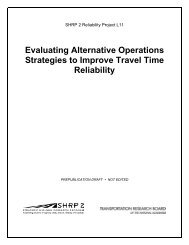Contemporary Approaches to Parking Pricing: - FHWA Operations
Contemporary Approaches to Parking Pricing: - FHWA Operations
Contemporary Approaches to Parking Pricing: - FHWA Operations
You also want an ePaper? Increase the reach of your titles
YUMPU automatically turns print PDFs into web optimized ePapers that Google loves.
• Disincentive Removal, where a monthly transit pass was provided for free <strong>to</strong> purchasers of monthly parking passes;<br />
• Marginal Rebate, where a monthly transit pass was provided free <strong>to</strong> purchasers of monthly parking passes, and<br />
those taking transit instead of parking any day of the month received a $2 rebate, which is reflective of the marginal<br />
parking cost of $7 per day and the marginal transit cost of $5 per day; and<br />
• PayGo Flex-Pass, which is the same as Disincentive Removal, except that a rebate of $7 would be provided on days<br />
where neither parking nor transit was used (with the <strong>to</strong>tal monthly rebate capped at half the cost of the monthly<br />
parking pass).<br />
The most flexible and successful of the incentive programs studied, PayGo Flex-Pass, led <strong>to</strong> a decline in driving days<br />
from 78.5 percent <strong>to</strong> 56.5 percent, a large reduction (Lari, et al., 2011).<br />
Travel allowances have also proved successful at changing travel behavior. Los Angeles County replaced free parking<br />
for its employees with a travel allowance and saw solo driving decrease from 53 <strong>to</strong> 47 percent of commute trips.<br />
CH2M Hill in Bellevue, Washing<strong>to</strong>n, replaced free parking with a travel allowance and saw solo driving decrease<br />
from 89 <strong>to</strong> 64 percent of commute trips (USDOT, 1994).<br />
As with any changes made <strong>to</strong> parking, cash-out programs and travel allowances can present challenges, but they<br />
may be overcome with careful implementation. The programs are also likely <strong>to</strong> increase costs slightly for employers;<br />
if employees do not use their payments for tax-deductible transportation expenses, employers must pay employment<br />
taxes on the amounts. Employers will also incur administrative costs. All these costs could, however, be offset<br />
by small reductions in travel allowances or parking subsidies (i.e., charging employees who decline a cash-out offer<br />
a small fee for parking).<br />
The United States Government has developed a number of documents <strong>to</strong> assist governments and<br />
employers that are interested in implementing cash-out programs. The <strong>FHWA</strong>’s Non-<strong>to</strong>ll <strong>Pricing</strong>: A Primer<br />
(2009) provides an overview of parking cash out. The Federal Transit Administration’s (FTA’s) TDM Status<br />
Report: <strong>Parking</strong> Cash Out (1994) provides travel reduction benefit estimates and implementation steps for<br />
government agencies wishing <strong>to</strong> implement parking cash out. The EPA’s <strong>Parking</strong> Cash Out: Implementing<br />
Commuter Benefits as One of the Nation’s Best Workplaces for Commuters (2005) is a how-<strong>to</strong> guide for<br />
employers wishing <strong>to</strong> implement a parking cash-out program. The EPA’s report also includes information<br />
on employer benefits and tax considerations. Less information has been published regarding travel allowances;<br />
however, the two strategies do not differ significantly in terms of implementation or cost.<br />
C o n t e m p o r a r y A p p r o a c h e s t o P a r k i n g P r i c i n g | 17















